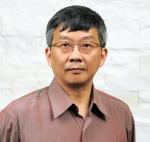CO oxidation on unsupported Au(55), Ag(55), and Au(25)Ag(30) nanoclusters
- Citation:
- Chang, C. M., Cheng C., & Wei C. M. (2008). CO oxidation on unsupported Au(55), Ag(55), and Au(25)Ag(30) nanoclusters. Journal of Chemical Physics. 128, 4., Mar, Number 12
Abstract:
Using density functional calculations, we demonstrate a catalytic reaction path with activation barriers of less than 0.5 eV for CO oxidation on the neutral and unsupported icosahedral nanoclusters of Au(55), Ag(55), and Au(25)Ag(30). Both CO and O(2) adsorb more strongly on these clusters than on the corresponding bulk surfaces. The reaction path consists of an intermediate involving OOCO complex through which the coadsorption energy of CO and O(2) on these clusters is expected to play an important role in the reaction. Based on the studies for the Au and Ag nanoclusters, a model alloy nanocluster of Au(25)Ag(30) was designed to provide a larger coadsorption energy for CO and O2 and was anticipated to be a better catalyst for CO oxidation from energetic analysis. (C) 2008 American Institute of Physics.
Notes:
ISI Document Delivery No.: 281ZKTimes Cited: 23Cited Reference Count: 36Cited References: BLOCHL PE, 1994, PHYS REV B, V50, P17953, DOI 10.1103/PhysRevB.50.17953 Bongiorno A, 2005, PHYS REV LETT, V95, DOI 10.1103/PhysRevLett.95.106102 Boyen HG, 2002, SCIENCE, V297, P1533, DOI 10.1126/science.1076248 Chen MS, 2004, SCIENCE, V306, P252, DOI 10.1126/science.1102420 Fu Q, 2003, SCIENCE, V301, P935, DOI 10.1126/science.1085721 Greeley J, 2004, NAT MATER, V3, P810, DOI 10.1038/nmat1223 Gross A, 2006, TOP CATAL, V37, P29, DOI 10.1007/s11244-006-0005-x Haberlen OD, 1997, J CHEM PHYS, V106, P5189 Hakkinen H, 2001, J AM CHEM SOC, V123, P9704, DOI 10.1021/ba0165180 HAMMER B, 1995, NATURE, V376, P238, DOI 10.1038/376238a0 Haruta M, 1997, CATAL TODAY, V36, P153, DOI 10.1016/S0920-5861(96)00208-8 Haruta Masatake, 2003, Chem Rec, V3, P75, DOI 10.1002/tcr.10053 HARUTA M, 1989, J CATAL, V115, P301, DOI 10.1016/0021-9517(89)90034-1 HOHENBERG P, 1964, PHYS REV B, V136, pB864, DOI 10.1103/PhysRev.136.B864 Inderwildi OR, 2007, SURF SCI, V601, pL103, DOI 10.1016/j.susc.2007.06.031 KHANNA SN, 2003, QUANTUM PHENOMENA CL KOHN W, 1965, PHYS REV, V140, P1133 Kresse G, 1999, PHYS REV B, V59, P1758, DOI 10.1103/PhysRevB.59.1758 KRESSE G, 1994, PHYS REV B, V49, P14251, DOI 10.1103/PhysRevB.49.14251 Laursen S, 2006, PHYS REV LETT, V97, DOI 10.1103/PhysRevLett.97.026101 Liu JH, 2005, J PHYS CHEM B, V109, P40, DOI 10.1021/jp044938g Liu ZP, 2003, PHYS REV LETT, V91, DOI 10.1103/PhysRevLett.91.266102 Liu ZP, 2002, J AM CHEM SOC, V124, P14770, DOI 10.1021/ja0205885 Liu ZP, 2005, PHYS REV LETT, V94, DOI 10.1103/PhysRevLett.94.196102 Lopez N, 2002, J AM CHEM SOC, V124, P11262, DOI 10.1021/ja026998a MILLS G, 1994, PHYS REV LETT, V72, P1124, DOI 10.1103/PhysRevLett.72.1124 Molina LM, 2004, PHYS REV B, V69, DOI 10.1103/PhysRevB.69.155424 Molina LM, 2003, PHYS REV LETT, V90, DOI 10.1103/PhysRevLett.90.206102 NOSE S, 1984, J CHEM PHYS, V81, P511 Perdew JP, 1996, PHYS REV LETT, V77, P3865, DOI 10.1103/PhysRevLett.77.3865 Pyykko P, 2004, ANGEW CHEM INT EDIT, V43, P4412, DOI 10.1002/anie.200300624 Stolcic D, 2003, J AM CHEM SOC, V125, P2848, DOI 10.1021/ja0293406 Valden M, 1998, SCIENCE, V281, P1647, DOI 10.1126/science.281.5383.1647 Wang AQ, 2005, J PHYS CHEM B, V109, P18860, DOI 10.1021/jp051530q Wang JG, 2006, PHYS REV LETT, V97, DOI 10.1103/PhysRevLett.97.136107 Yoon B, 2005, SCIENCE, V307, P403, DOI 10.1126/science.1104168Chang, C. M. Cheng, C. Wei, C. M.AMER INST PHYSICSMELVILLE

